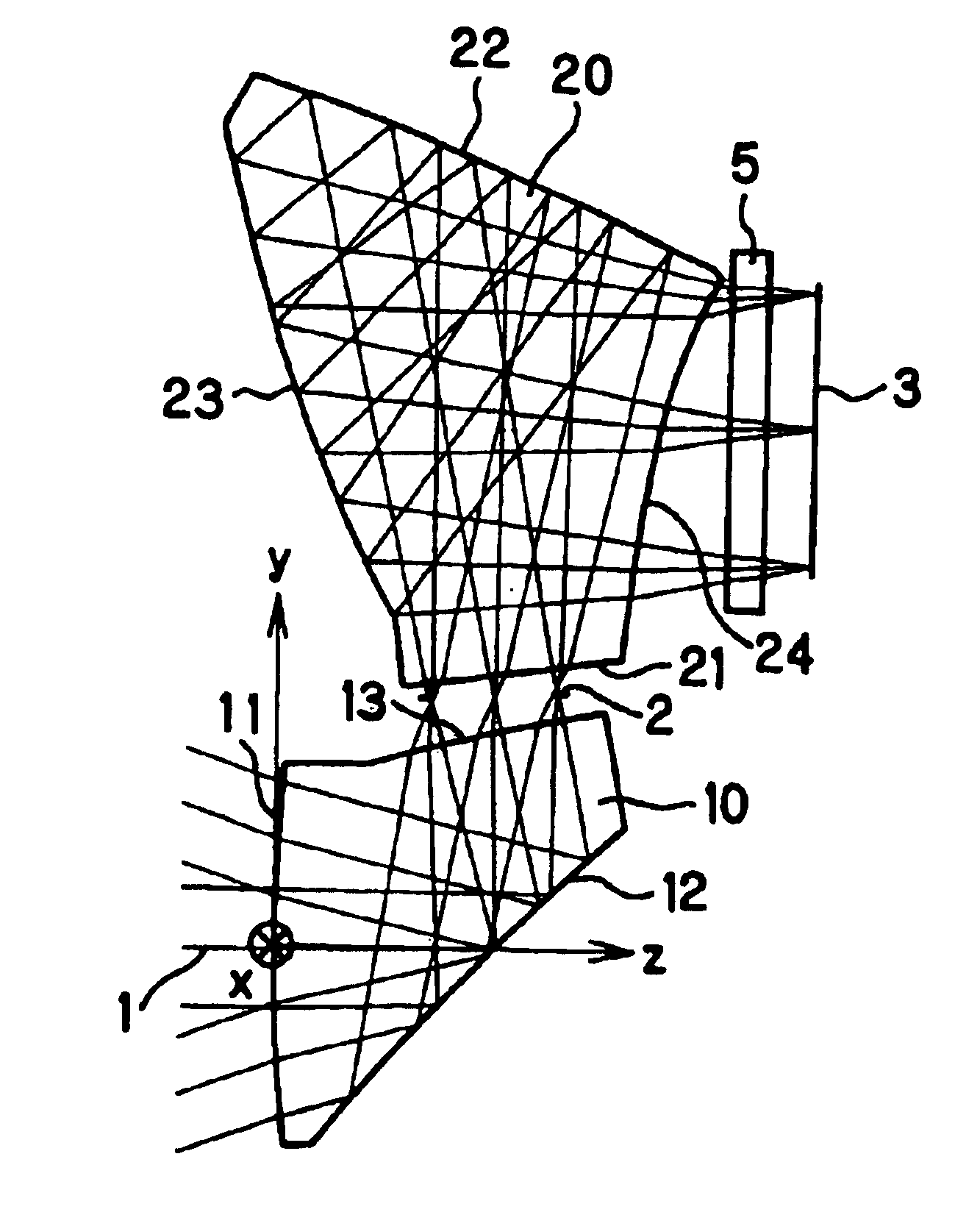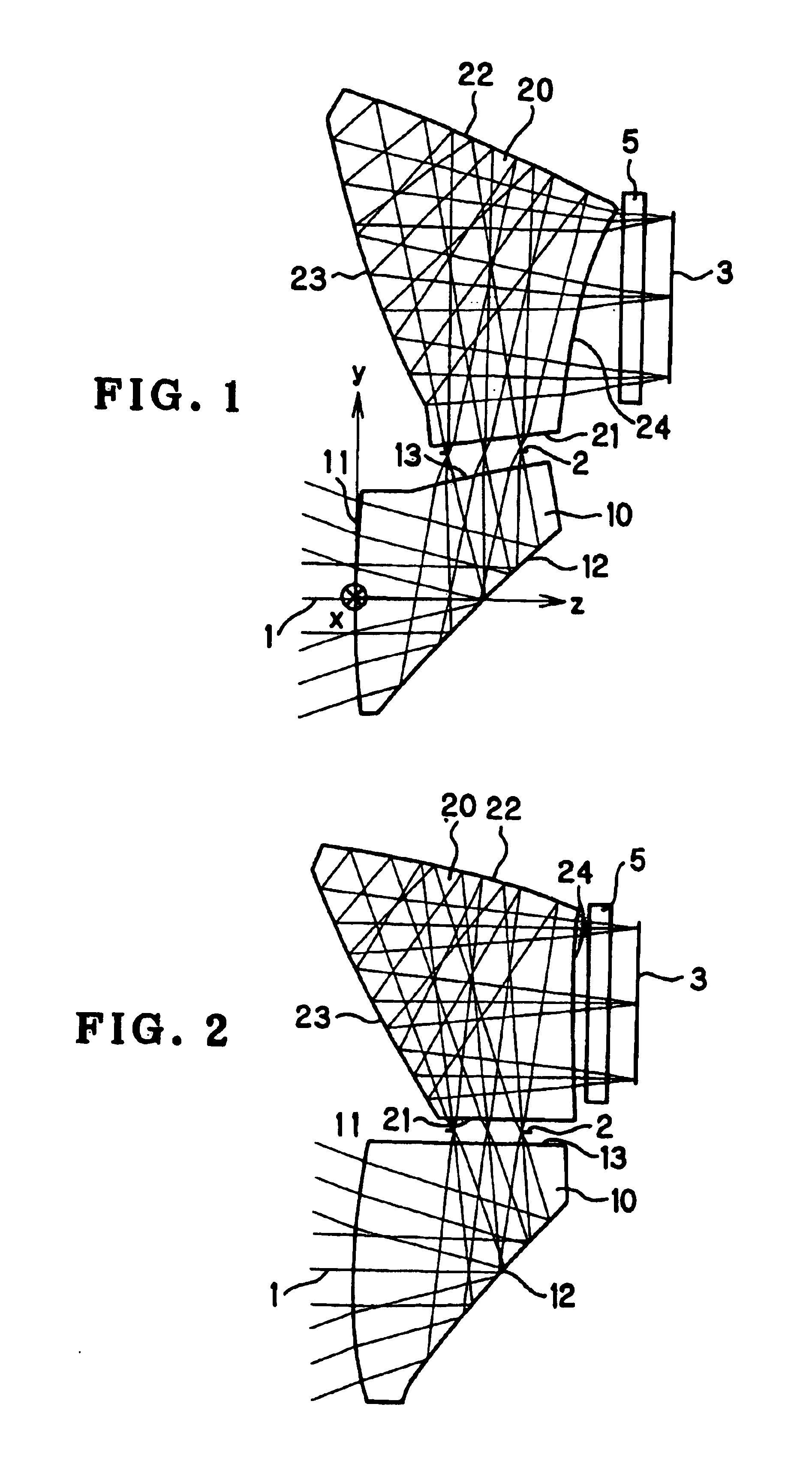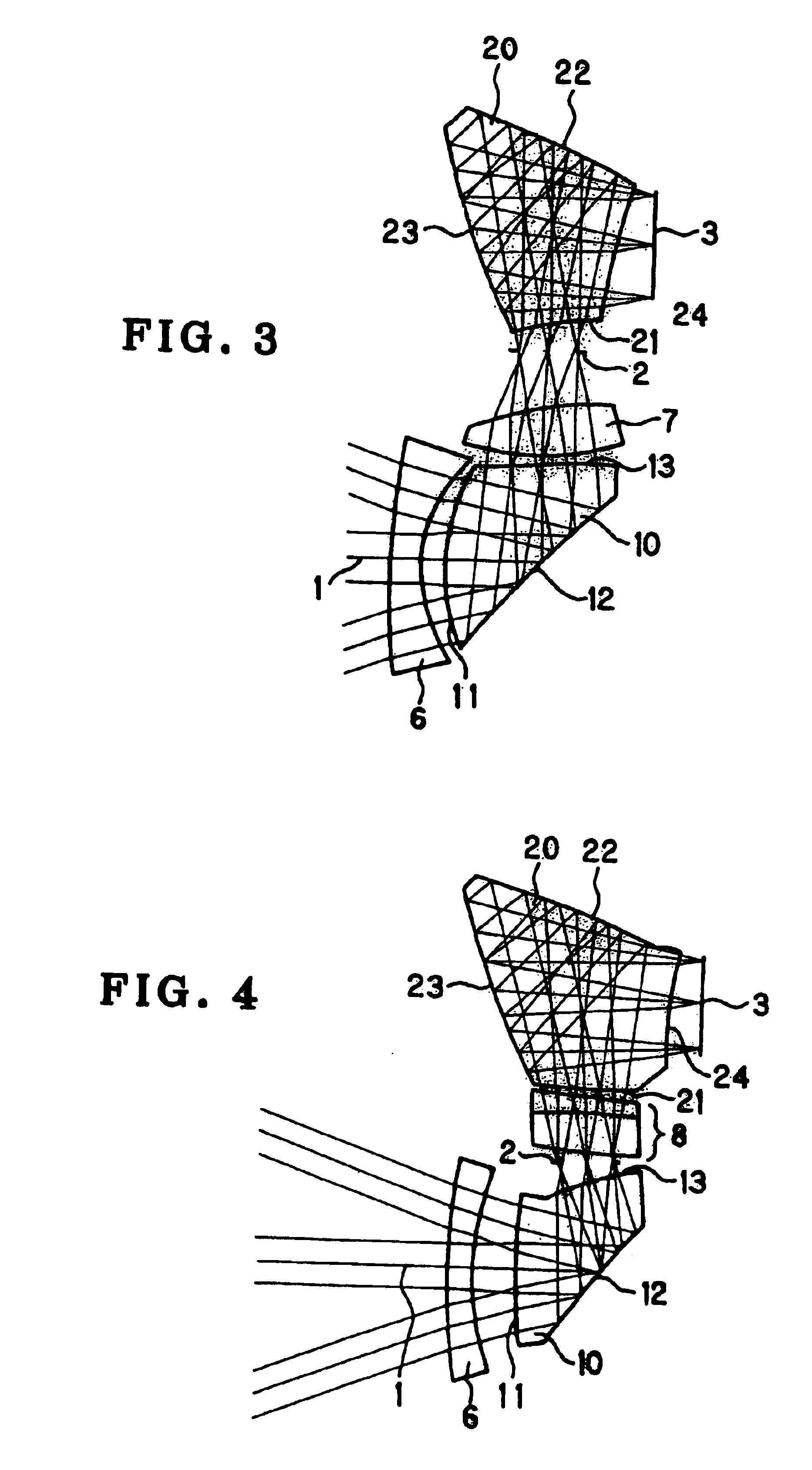Image-forming optical system
a technology of optical systems and optical paths, applied in the field of image-forming optical systems, can solve the problems of unfavorable cost increase, tightening of the accuracy required for each surface, and transferring surface accuracy errors and decentration accuracy errors while being added, etc., to achieve tightening of the tolerances required in the manufacturing process, reducing the cost of production, and improving space utilization efficiency
- Summary
- Abstract
- Description
- Claims
- Application Information
AI Technical Summary
Benefits of technology
Problems solved by technology
Method used
Image
Examples
example 1
[0114]
SurfaceRadius ofSurfaceDisplacementRefractiveAbbe'sNo.curvatureseparationand tiltindexNo.Object∞∞plane1FFS[1]1.525455.82FFS[2] (RE)(1)1.525455.83FFS[3](2)4∞ (Stop)(3)5FFS[4](4)1.525455.86FFS[5] (RE)(5)1.525455.87FFS[6] (RE)(6)1.525455.88FFS[7](7)9∞(8)1.523055.010∞(9)Image∞(10)planeFFS[1]C4 −1.0876 × 10−2C6 1.8722 × 10−2C8 3.8132 × 10−3C10 −2.3015 × 10−3C11 −9.4351 × 10−4C13 7.1890 × 10−4C15 −2.0238 × 10−4C17 7.5766 × 10−7C19 6.5506 × 10−6C21 −2.2659 × 10−6FFS[2]C4 −3.4639 × 10−3C6 8.1383 × 10−3C8 −1.9758 × 10−4C10 2.9221 × 10−4C11 −5.5124 × 10−5C13 1.5479 × 10−4C15 6.6936 × 10−5C17 −8.5001 × 10−5C19 2.5214 × 10−5C21 5.5366 × 10−6FFS[3]C4 8.2999 × 10−3C6 −1.3417 × 10−2C8 −1.1302 × 10−2C10 3.6790 × 10−3C11 −6.3232 × 10−3C13 1.0246 × 10−3C15 −2.8677 × 10−3C17 −2.5809 × 10−5C19 7.5650 × 10−5C21 2.5953 × 10−5FFS[4]C4 −1.1382 × 10−2C6 8.5352 × 10−3C8 −3.7586 × 10−4C10 −2.4037 × 10−3C11 −6.7309 × 10−3C13 1.8517 × 10−4C15 −2.4090 × 10−3C17 3.3122 × 10−6C19 −3.6259 × 10−5C21 6.6768 × 1...
example 2
[0115]
SurfaceRadius ofSurfaceDisplacementRefractiveAbbe'sNo.curvatureseparationand tiltindexNo.Object∞∞plane1FFS[1]1.525455.82FFS[2] (RE)(1)1.525455.83∞(2)4∞ (Stop)(3)5∞(4)1.525455.86FFS[3] (RE)(5)1.525455.87FFS[4] (RE)(6)1.525455.88FFS[5](7)9∞(8)1.523055.010∞(9)Image∞(10)planeFFS[1]C4 −8.3188 × 10−3C6 3.4101 × 10−2C8 −1.4706 × 10−3C10 −1.1420 × 10−3C11 −6.5609 × 10−5C13 −1.7003 × 10−4C15 2.9132 × 10−4C17 9.7267 × 10−5C19 1.5357 × 10−5C21 −7.7116 × 10−6FFS[2]C4 −6.7737 × 10−4C6 9.5729 × 10−3C8 −4.6635 × 10−5C10 3.2706 × 10−4C11 4.7807 × 10−5C13 −1.7131 × 10−6C15 5.7208 × 10−5C17 1.8852 × 10−5C19 −1.0239 × 10−5C21 5.2505 × 10−6FFS[3]C4 1.8027 × 10−2C6 1.9843 × 10−2C8 2.7422 × 10−4C10 6.5409 × 10−4C11 −5.5779 × 10−5C13 7.9255 × 10−6C15 −1.3926 × 10−5C17 −1.0429 × 10−5C19 −2.8931 × 10−5C21 3.4435 × 10−7FFS[4]C4 1.5424 × 10−2C6 1.1204 × 10−2C8 −1.0357 × 10−4C10 3.0996 × 10−4C11 5.5084 × 10−5C13 4.6769 × 10−5C15 2.6581 × 10−5C17 1.3231 × 10−5C19 −3.7769 × 10−5C21 −2.3725 × 10−7FFS[5]C4 3...
example 3
[0116]
SurfaceRadius ofSurfaceDisplacementRefractiveAbbe'sNo.curvatureseparationand tiltindexNo.Object∞∞plane1FFS[1]1.525455.82FFS[2](1)3FFS[3](2)1.525455.84FFS[4] (RE)(3)1.525455.85FFS[5](4)6FFS[6](5)1.525455.87FFS[7](6)8∞ (Stop)(7)9FFS[8](8)1.525455.810FFS[9] (RE)(9)1.525455.811FFS[10](10)1.525455.8(RE)12FFS[11](11)Image∞(12)planeFFS[1]C4 2.0000 × 10−2C6 2.0000 × 10−2C4 1.1946 × 10−2C10 −5.8807 × 10−4C11 −7.9166 × 10−4C13 −7.1566 × 10−4C15 −1.0835 × 10−4FFS[2]C4 1.0000 × 10−1C6 1.0000 × 10−1C8 6.8147 × 10−3C10 4.9188 × 10−3C11 4.4453 × 10−4C13 1.4154 × 10−3C15 3.3510 × 10−4FFS[3]C4 1.7171 × 10−2C6 7.6775 × 10−2C8 3.1854 × 10−3C10 3.3543 × 10−3FFS[4]C4 −3.9048 × 10−3C6 1.0860 × 10−2C8 −1.3280 × 10−4C10 5.5067 × 10−4C11 −1.0727 × 10−4C13 −1.5579 × 10−4C15 1.2262 × 10−6C17 −2.4134 × 10−6C19 1.8572 × 10−6C21 1.4336 × 10−7FFS[5]C4 5.6286 × 10−3C6 −6.0994 × 10−3C8 −1.8177 × 10−2C10 6.0163 × 10−3FFS[6]C4 3.8725 × 10−2C6 5.1304 × 10−2C8 3.2587 × 10−3C10 −1.1068 × 10−3FFS[7]C4 −4.2787 × 10−...
PUM
 Login to View More
Login to View More Abstract
Description
Claims
Application Information
 Login to View More
Login to View More - R&D
- Intellectual Property
- Life Sciences
- Materials
- Tech Scout
- Unparalleled Data Quality
- Higher Quality Content
- 60% Fewer Hallucinations
Browse by: Latest US Patents, China's latest patents, Technical Efficacy Thesaurus, Application Domain, Technology Topic, Popular Technical Reports.
© 2025 PatSnap. All rights reserved.Legal|Privacy policy|Modern Slavery Act Transparency Statement|Sitemap|About US| Contact US: help@patsnap.com



